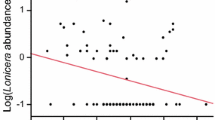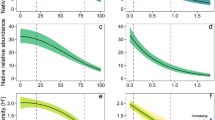Abstract
A fundamental question in invasive plant ecology is whether invasive and native plants have different ecological roles. Differences in functional traits have been explored, but we lack a comparison of the factors affecting the spread of co-occurring natives and invasives. Some have proposed that to succeed, invasives would colonize a wider variety of sites, would disperse farther, or would be better at colonizing sites with more available light and soil nutrients than natives. We examined patterns of spread over 70 years in a regenerating forest in Connecticut, USA, where both native and invasive species acted as colonizers. We compared seven invasive and 19 native species in the characteristics of colonized plots, variation in these characteristics, and the importance of site variables for colonization. We found little support for the hypotheses that invasive plants succeed by dispersing farther than native plants or by having a broader range of site tolerances. Colonization by invasives was also not more dependent on light than colonization by natives. Like native understory species, invasive plants spread into closed-canopy forest and species-rich communities despite earlier predictions that these communities would resist invasion. The biggest differences were that soil nitrate and the initial land cover being open field increased the odds of colonization for most invasives but only for some natives. In large part, though, the spread of native and invasive plants was affected by similar factors.






Similar content being viewed by others
Availability of data and material
The datasets used and/or analyzed during the current study are available from the corresponding author on reasonable request.
References
Agresti A (1996) Introduction to categorical data analysis, 2nd edn. John Wiley & Sons Inc., Hoboken, NJ
Banasiak SE, Meiners SJ (2009) Long term dynamics of Rosa multiflora in a successional system. Biol Invasions 11(2):215–224. https://doi.org/10.1007/s10530-008-9226-1
Bates D, Mächler M, Bolker B, Walker S (2015) Fitting linear mixed-effects models using Ime4. J Stat Softw 67(1):48. https://doi.org/10.18637/jss.v067.i01
Canham CD, Frazer GW, Sallaway P, Marinakis D (1999) Gap light analyzer. Simon Fraser University, Cary Institute of Ecosystem Studies
Caplan J, Stone B, Faillace C, Lafond J, Baumgarten J, Mozdzer T, Dighton J, Meiners S, Grabosky J, Ehrenfeld J (2017) Nutrient foraging strategies are associated with productivity and population growth in forest shrubs. Ann Bot 119(6):977–988. https://doi.org/10.1093/aob/mcw271
Chan M (2020) rwa: perform a relative weights analysis. https://CRAN.R-project.org/package=rwa
Compagnoni A, Halpern CB (2009) Properties of native plant communities do not determine exotic success during early forest succession. Ecography 32(3):449–458. https://doi.org/10.1111/j.1600-0587.2008.05739.x
Cribari-Neto F (2004) Asymptotic inference under heteroskedasticity of unknown form. Comput Stat Data Anal 45(2):215–233. https://doi.org/10.1016/S0167-9473(02)00366-3
Davidson AM, Jennions M, Nicotra AB (2011) Do invasive species show higher phenotypic plasticity than native species and if so, is it adaptive? a meta-analysis. Ecol Lett 14(4):419–431. https://doi.org/10.1111/j.1461-0248.2011.01596.x
Davis MA, Thompson K, Grime JP (2001) Charles S. Elton and the dissociation of invasion ecology from the rest of ecology. Divers Distrib 7(97):102. https://doi.org/10.1046/j.1472-4642.2001.00099.x
DeGasperis BG, Motzkin G (2007) Windows of opportunity: historical and ecological controls on Berberis thunbergii invasions. Ecology 88(12):3115–3125. https://doi.org/10.1890/06-2014.1
Dreyer GD, Jones C et al (2014) Native and naturalized vascular plants of Connecticut checklist. Connecticut Botanical Society, New Haven, CT
Duguid MC, Frey BR, Ellum DS, Kelty M, Ashton MS (2013) The influence of ground disturbance and gap position on understory plant diversity in upland forests of southern New England. For Ecol Manag 303:148–159. https://doi.org/10.1016/j.foreco.2013.04.018
Elton CS (1958) The ecology of invasions by animals and plants. Springer, New York. https://doi.org/10.1007/978-1-4899-7214-9
Eschtruth AK, Battles JJ (2009) Assessing the relative importance of disturbance, herbivory, diversity, and propagule pressure in exotic plant invasion. Ecol Monogr 79(2):265–280. https://doi.org/10.1890/08-0221.1
Flinn KM, Velland M (2005) Recovery of forest plant communities in post-agricultural landscapes. Front Ecol Environ 3(5):243–250. https://doi.org/10.1890/1540-9295(2005)003[0243:ROFPCI]2.0.CO;2
Flory SL, Clay K (2009) Effects of roads and forest successional age on experimental plant invasions. Biol Conserv 142(11):2531–2537. https://doi.org/10.1016/j.biocon.2009.05.024
Foster DR, Motzkin G, Slater B (1998) Land-use history as long-term broad-scale disturbance: regional forest dynamics in central New England. Ecosystems 1(1):96–119. https://doi.org/10.1007/s100219900008
Foster DR, Swanson F, Aber J, Burke I, Brokaw N, Tilman D, Knapp A (2009) The importance of land-use legacies to ecology and conservation. Bioscience 53:77–88. https://doi.org/10.1641/0006-3568(2003)053[0077:TIOLUL]2.0.CO;2
Gurevitch J, Howard TG, Ashton IW, Leger EA, Howe KM, Woo E, Lerdau M (2008) Effects of experimental manipulation of light and nutrients on establishment of seedlings of native and invasive woody species in Long Island, NY forests. Biol Invasions 10(6):821–831. https://doi.org/10.1007/s10530-008-9241-2
Herron PM, Martine CT, Latimer AM, Leicht-Young SA (2007) Invasive plants and their ecological strategies: prediction and explanation of woody plant invasion in New England. Divers Distrib 13(5):633–644. https://doi.org/10.1111/j.1472-4642.2007.00381.x
Higgins SI, Richardson DM (1999) Predicting plant migration rates in a changing world: the role of long-distance dispersal. Am Nat 153(5):464–475. https://doi.org/10.1086/303193
Holmes AM, Matlack GR (2019) Non-native plant species show a legacy of agricultural history in second-growth forests of southeastern Ohio. Biol Invasions 21:3063–3076. https://doi.org/10.1007/s10530-019-02029-2
Howard TG, Gurevitch J, Hyatt L, Carreiro M, Lerdau M (2004) Forest invasibility in communities in southeastern New York. Biol Invasions 6(4):393–410. https://doi.org/10.1023/B:BINV.0000041559.67560.7e
Hulme PE (2008) Phenotypic plasticity and plant invasions: is it all jack? Funct Ecol 22(1):3–7. https://doi.org/10.1111/j.1365-2435.2007.01369.x
Iannone BV, Carnevale S, Main MB, Hill JE, McConnell JB, Johnson SA, Enloe SF, Andreu M, Bell EC, Cuda JP, Baker SM (2020) Invasive species terminology: standardizing for stakeholder education. J Ext 58(3):27. https://doi.org/10.34068/joe.58.03.27
Kalkhan MA, Stohlgren TJ (2000) Using multi-scale sampling and spatial cross-correlation to investigate patterns of plant species richness. Environ Monit Assess 64(3):591–605. https://doi.org/10.1023/A:1006329707198
Leicht-Young SA, Silander JA, Latimer AM (2007) Comparative performance of invasive and native Celastrus species across environmental gradients. Oecologia 154(2):273–282. https://doi.org/10.1007/s00442-007-0839-3
Lemoine NP, Shue J, Verrico B, Erickson D, Kress W, Parker J (2015) Phylogenetic relatedness and leaf functional traits, not introduced status, influence community assembly. Ecology 96(10):2605–2612. https://doi.org/10.1890/14-1883.1
Levine JM, D’Antonio CM (1999) Elton revisited: a review of evidence linking diversity and invasibility. Oikos 87(1):15–26. https://doi.org/10.2307/3546992
Martin PH, Canham CD, Marks PL (2009) Why forests appear resistant to exotic plant invasions: intentional introductions, stand dynamics, and the role of shade tolerance. Front Ecol Environ 7(3):142–149. https://doi.org/10.1890/070096
Martin PH, Canham CD, Kobe RK (2010) Divergence from the growth–survival trade-off and extreme high growth rates drive patterns of exotic tree invasions in closed-canopy forests. J Ecol 98(4):778–789. https://doi.org/10.1111/j.1365-2745.2010.01666.x
McLane CR, Battaglia LL, Gibson DJ, Groninger JW (2012) Succession of exotic and native species assemblages within restored floodplain forests: a test of the parallel dynamics hypothesis. Restor Ecol 20(2):202–210. https://doi.org/10.1111/j.1526-100x.2010.00763.x
McLauchlan K (2006) The nature and longevity of agricultural impacts on soil carbon and nutrients: a review. Ecosystems 9(8):1364–1382. https://doi.org/10.1007/s10021-005-0135-1
Meiners SJ (2007) Native and exotic plant species exhibit similar population dynamics during succession. Ecology 88(5):1098–1104. https://doi.org/10.1890/06-1505
Meiners SJ, Pickett STA, Cadenasso ML (2001) Effects of plant invasions on the species richness of abandoned agricultural land. Ecography 24(6):633–644. https://doi.org/10.1111/j.1600-0587.2001.tb00525.x
Meiners SJ, Cadenasso ML, Pickett STA (2004) Beyond biodiversity: individualistic controls of invasion in a self-assembled community. Ecol Lett 7(2):121–126. https://doi.org/10.1111/j.1461-0248.2003.00563.x
Meiners SJ, Rye T, Klass J (2009) On a level field: the utility of studying native and non-native species in successional systems. Appl Veg Sci 12:45–53. https://doi.org/10.1111/j.1654-109X.2009.01003.x
Nakagawa S, Poulin R, Mengersen K, Reinhold K, Engqvist L, Lagisz M, Senior AM (2015) Meta-analysis of variation: ecological and evolutionary applications and beyond. Methods Ecol Evol 6(2):143–152. https://doi.org/10.1111/2041-210X.12309
Nathan R, Klein E, Robledo-Arnuncio, Revilla E (2012) Dispersal kernels: review. In: Clobert J, Baguette M, Benton TG, Bullock JM (eds) Dispersal ecology and evolution, 1st edn. Oxford University Press Oxford, UK, pp 186–210. https://doi.org/10.1093/acprof:oso/9780199608898.003.0015
Niering WA, Goodwin RH (1962) Ecological studies in the Connecticut Arboretum Natural Area I. introduction and a survey of vegetation types. Ecology 43(1):41–54. https://doi.org/10.2307/1932038
Proença-Ferreira A, Borda-de-Água L, Porto M, Mira A, Moreira F, Pita R (2023) dispfit: an R package to estimate species dispersal kernels. Ecol Inform 75:102018. https://doi.org/10.1016/j.ecoinf.2023.102018
Pyšek P, Richardson DM (2007) Traits associated with invasiveness in alien plants: where do we stand? In: Nentwig W (ed) Biological invasions. Ecological Studies, vol 193. Springer, Berlin, pp 97-125. https://doi.org/10.1007/978-3-540-36920-2_7
R Core Team (2022) R: a language and environment for statistical computing. R Foundation for Statistical Computing, Vienna
Reichard SE (1997) Prevention of invasive plant introductions on national and local levels. In: Luken JO, Thieret JW (eds) Assessment and management of plant invasions. Springer series on environmental management Springer, New York, pp 215–227. https://doi.org/10.1007/978-1-4612-1926-2_16
Rejmánek M, Richardson D, Pyšek P (2013) Plant invasions and invasibility of plant communities. In: van der Maarel E, Franklin J (eds) Vegetation Ecology, 2nd edn John Wiley & Sons Ltd, Hoboken, NJ, pp 387–424. https://doi.org/10.1002/9781118452592.ch13
Richardson D, Allsopp N, D’Antonio C, Milton S, Rejmánek M (2000) Plant invasions-the role of mutualisms. Biol Rev Camb Philos Soc 75:65–93. https://doi.org/10.1111/j.1469-185X.1999.tb00041.x
Rosenberg MS, Rothstein HR, Gurevitch J (2013) Effect sizes: conventional choices and calculations. In: Koricheva J, Mengersen K, Gurevitch J (eds) Handbook of meta-analysis in ecology and evolution. Princeton University Press, Princeton, NJ, pp 61–71
Schulz BK, Gray AN (2013) The new flora of northeastern USA: quantifying introduced plant species occupancy in forest ecosystems. Environ Monit Assess 185(5):3931–3957. https://doi.org/10.1007/s10661-012-2841-4
Small MJ, Small CJ, Dreyer GD (2005) Changes in a hemlock-dominated forest following woolly adelgid infestation in southern New England. J Torrey Bot Soc 132(3):458–470. https://doi.org/10.3159/1095-5674(2005)132[458:CIAHFF]2.0.CO;2
Stohlgren TJ, Barnett DT, Kartesz JT (2003) The rich get richer: patterns of plant invasions in the United States. Front Ecol Environ 1(1):11–14. https://doi.org/10.1890/1540-9295(2003)001[0011:TRGRPO]2.0.CO;2
Tonidandel S, LeBreton JM (2011) Relative importance analysis: a useful supplement to regression analysis. J Bus Psychol 26(1):1–9. https://doi.org/10.1007/s10869-010-9204-3
Torchiano M (2020) effsize: efficient effect size computation. https://CRAN.R-project.org/package=effsize
van Kleunen M, Weber E, Fischer M (2010) A meta-analysis of trait differences between invasive and non-invasive plant species. Ecol Lett 13(2):235–245. https://doi.org/10.1111/j.1461-0248.2009.01418.x
Walker LR, Chapin FS (1987) Interactions among processes controlling successional change. Oikos 50(1):131–135. https://doi.org/10.2307/3565409
Zeileis A, Hothorn T (2002) Diagnostic checking in regression relationships. R News 2(3):7–10
Acknowledgements
Thank you to Priya Kohli for advice with the statistical analysis, William A. Niering and Richard H. Goodwin for setting up the permanent plots, and many students and faculty who collected the long-term data. We also thank two reviewers whose suggestions improved this paper.
Funding
Connecticut College, Goodwin Environmental Research Fellowship, Matthew Yamamoto.
Author information
Authors and Affiliations
Contributions
Both authors conceived and designed the study. MHY analyzed the data with significant input from CCJ, and both authors wrote the manuscript.
Corresponding author
Ethics declarations
Conflict of interest
The authors declare that they have no conflict of interest.
Additional information
Communicated by Yu-Long Feng.
This long-term study is the first direct comparison of the spread of co-occurring native and invasive plants in forests. While the spread of natives and invasives have historically been studied separately, our results demonstrate that knowledge on native plant succession and community assembly can aid in the critical goal of understanding how invasive plants invade.
Supplementary Information
Below is the link to the electronic supplementary material.
Rights and permissions
Springer Nature or its licensor (e.g. a society or other partner) holds exclusive rights to this article under a publishing agreement with the author(s) or other rightsholder(s); author self-archiving of the accepted manuscript version of this article is solely governed by the terms of such publishing agreement and applicable law.
About this article
Cite this article
Yamamoto, M.H., Jones, C.C. Comparing long-term patterns of spread of native and invasive plants in a successional forest. Oecologia 205, 13–25 (2024). https://doi.org/10.1007/s00442-024-05554-7
Received:
Accepted:
Published:
Issue Date:
DOI: https://doi.org/10.1007/s00442-024-05554-7




